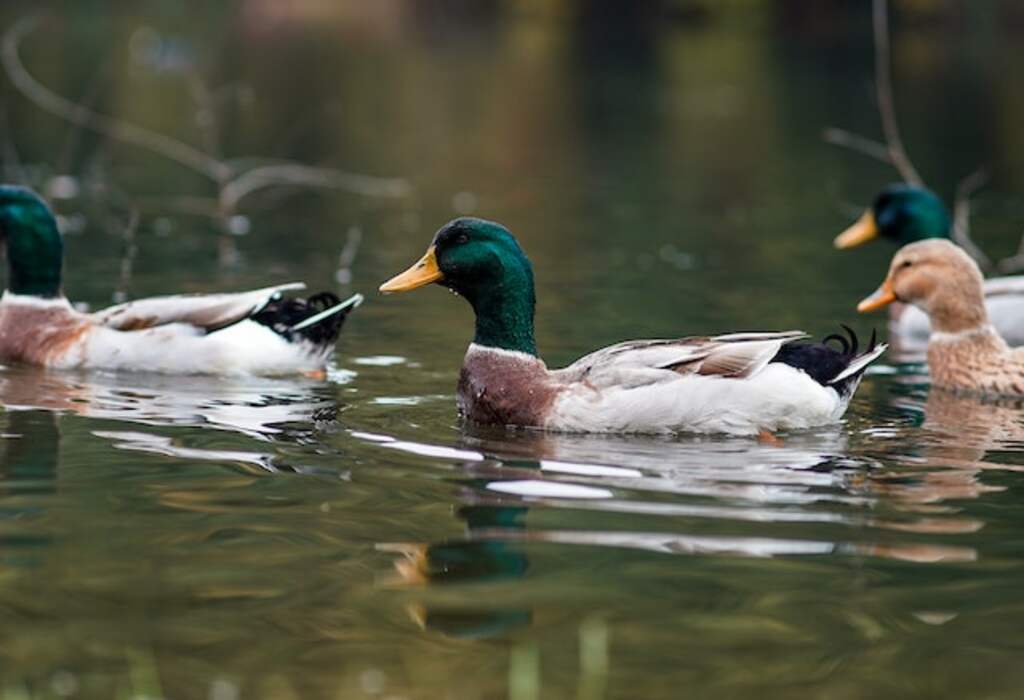What do ducks eat in a pond? Well, let’s just say they have a quack-tastic menu that will make your mouth water (or waddle, in this case). From underwater delicacies to unexpected snacks, these feathered foodies know how to indulge.
Get ready to dive into the delectable world of duck dining as we uncover their surprising culinary preferences and uncover some jaw-dropping facts along the way. Hungry for more? Let’s paddle on!
Table of Contents
- 1 The Importance of Understanding What Ducks Eat in a Pond
- 2 General Diet of Ducks
- 3 Plant-Based Diet
- 4 Animal-Based Diet
- 5 Rarely Known Small Details
- 6 Conclusion
- 7 FAQs: What Do Ducks Eat In A Pond?
- 7.1 What do ducks eat in a pond?
- 7.2 Can you feed ducks bread in a pond?
- 7.3 What is the best food to feed ducks in a pond?
- 7.4 Is it illegal to feed ducks in a pond?
- 7.5 How often should you feed ducks in a pond?
- 7.6 How much food should you give ducks in a pond?
- 7.7 What should you not feed ducks in a pond?
- 7.8 Can ducks survive on pond food alone?
- 7.9 Why is it important not to overfeed ducks in a pond?
- 7.10 Can ducks eat fish in a pond?
- 8 Author
The Importance of Understanding What Ducks Eat in a Pond
When we think about ducks, the first things that come to mind are their bright colors and cute waddling. But have you ever stopped to think about what they eat in a pond?
Understanding the diet of these birds is crucial for conservation efforts and maintaining healthy ecosystems.
Ducks play an important role in the food chain of many wetland ecosystems. As omnivores, they have a diverse diet that includes both plant and animal matter.
By eating plants like algae, grasses, and aquatic plants, they help control their growth and prevent overgrowth from taking over the pond.
When it comes to eating animals like insects, mollusks, and small fish, they help keep populations in check and maintain balance in the ecosystem.
Furthermore, ducks are migratory birds that travel long distances during certain times of the year. Knowing what they eat is essential for ensuring there is enough food available along their migration routes.
Lack of food can lead to starvation or force ducks to resort to eating unnatural or unhealthy foods. But understanding what ducks eat goes beyond just conservation efforts.
It’s also interesting to see how their unique beaks help them filter out food from water while swimming or diving underwater.
Additionally, some species of duck have been known to consume small amphibians like frogs or tadpoles – a fact that may surprise many!
Understanding what ducks eat may seem trivial at first glance, but it’s actually incredibly important for maintaining healthy ecosystems and supporting conservation efforts.
By learning more about their diet habits and preferences, we can ensure these beautiful birds continue to thrive both now and in the future.
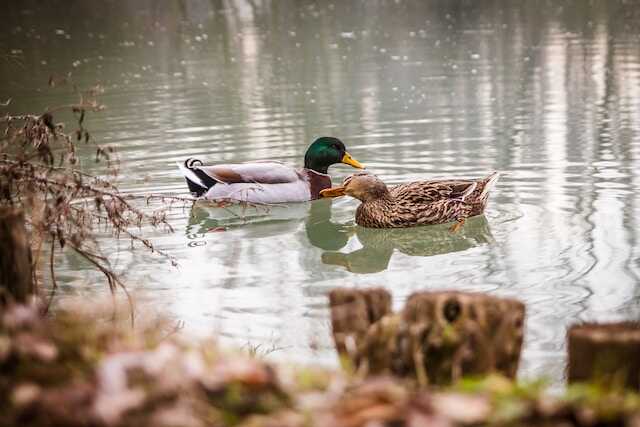
General Diet of Ducks
When it comes to the diet of ducks, it’s safe to say that they are omnivores. This means that they consume both plant and animal matter, although the exact ratio can vary depending on the species and location.
Generally speaking, ducks will eat whatever is available in their immediate environment. In terms of plant-based food, ducks love aquatic vegetation such as algae, grasses and aquatic plants.
This means that you’ll often find them paddling around in ponds or lakes, where there is plenty of plant life for them to munch on.
Some species of duck also like to eat grains like corn or wheat if they are available. On the other hand, when it comes to animal-based food sources, ducks are known for eating insects such as beetles or dragonflies.
They might also go after mollusks like snails or small crustaceans like shrimp. Some larger species may even target small fish as part of their diet.
Variations Depending on Species and Location
It’s important to note that what a duck eats can vary depending on both its species and location. For example, some species may prefer certain types of vegetation over others – while some may even eat different types of insects than others do.
Additionally, depending on where you are in the world (or even within a specific country), ducks may have access to different types of food sources due to climate or geography differences.
For example, a mallard living near a large urban park might feed primarily on bread crumbs thrown by visitors – whereas a wild duck living in a remote lake might exclusively consume natural foods found in nature.
It’s worth noting that while ducks typically have an omnivorous diet – this does not mean that they will eat just anything!
Ducks have been known to be picky eaters at times – especially if their natural habitat has been disrupted by human activity, pollution or other environmental factors.
Overall, understanding the general diet of ducks – and how it can vary depending on species and location – is crucial for conservation efforts.
By ensuring that there are enough natural food sources available for these fascinating creatures, we can help to maintain healthy ecosystems and keep duck populations thriving.
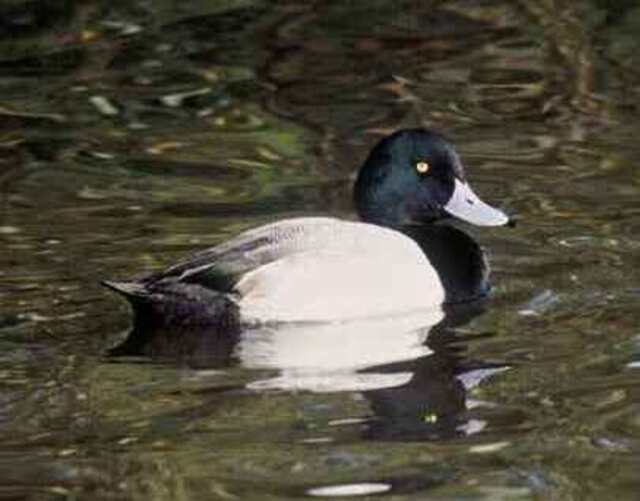
Plant-Based Diet
The Vegetarians of the Pond
Ducks are known to be omnivores, but they still rely heavily on plant-based diets, especially in ponds where there is an abundance of vegetation. The types of plants that ducks consume vary depending on the species and location.
However, some common plants include algae, grasses, and aquatic plants. Algae are tiny organisms that make up a significant portion of a duck’s diet in ponds.
They are abundant in almost every water body and grow thickly during warm weather seasons when there’s enough sunlight to support their growth. Ducks use their unique bills to filter out algae from the water surface as they feed.
Grasses are also an essential part of a duck’s diet in ponds since they provide valuable nutrients such as protein and carbohydrates needed for growth and energy. Ducks prefer tender shoots over mature blades as they are easier to digest.
Aquatic plants like pondweeds, water lilies, and bladderwort also make up a significant portion of a duck’s plant-based diet in ponds. These plants provide food for ducks year-round, since they can survive throughout all seasons.
Duck Beaks – An Organically Perfect Filtering Mechanism
The beak is one of the essential tools that help ducks filter out food from water bodies effectively. A duck’s bill has several adaptations that allow it to extract different types of food from their surroundings.
For example, many ducks have lamellae (comb-like structures) lining their bills that act like filters to trap food particles while enabling them to filter out excess water simultaneously.
This adaptation enables ducks to eat aquatic vegetation without ingesting excess amounts of water or mud with every bite.
Furthermore, some species have long, slender bills with serrated edges used for plucking small insects off surfaces or spearing small fish underwater.
Understanding how ducks use their bills to filter out food from the water is crucial in conserving their population and ensuring that they remain healthy.
By protecting their habitats and preserving vegetation, we can help ensure that these beautiful birds continue to thrive in the ponds that surround us.
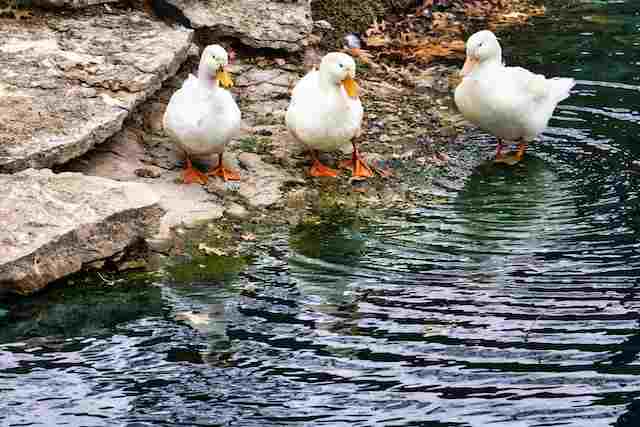
Animal-Based Diet
The Hunt Is On: Types of Animals Ducks Eat in Ponds
Ducks are omnivorous, which means they feed on both plant and animal matter. When it comes to their animal-based diet, ducks consume a variety of creatures that inhabit ponds and other wetland areas.
Insects, mollusks, and small fish make up a significant portion of their diet.
One common type of insect that ducks eat is the dragonfly. These speedy predators can be difficult to catch, but ducks use their quick reflexes and powerful wings to swoop down and snatch them up from the water’s surface.
Other insects that ducks enjoy include beetles, ants, and flies. Mollusks are another food source for ducks in ponds.
Snails and clams are among the most popular types of mollusks that ducks eat. These creatures often cling to underwater plants or rocks in shallow areas of the pond or lake.
Diving for Dinner: How Ducks Catch Prey Underwater
Ducks have evolved specialized adaptations to help them hunt underwater prey efficiently. For starters, their webbed feet are excellent at propelling them through the water with ease.
Additionally, they have streamlined bodies with flat bills that help reduce drag as they swim.
When looking for food underwater, ducks will often dive below the surface in search of small fish or other aquatic creatures hiding among the plants or rocks on the pond floor.
They can hold their breath for several seconds at a time while submerged before coming back up for air.
Once a duck has spotted its prey and is ready to catch it, it will extend its neck forward with its bill open wide like a pair of tongs.
The duck then dives quickly towards its target while simultaneously closing its bill around it before swimming back up to the surface triumphantly with dinner in tow.
Overall, ducks have a diverse and interesting diet that includes both plant and animal matter.
Understanding what they eat in ponds can help us appreciate the vital role these birds play in maintaining healthy ecosystems.
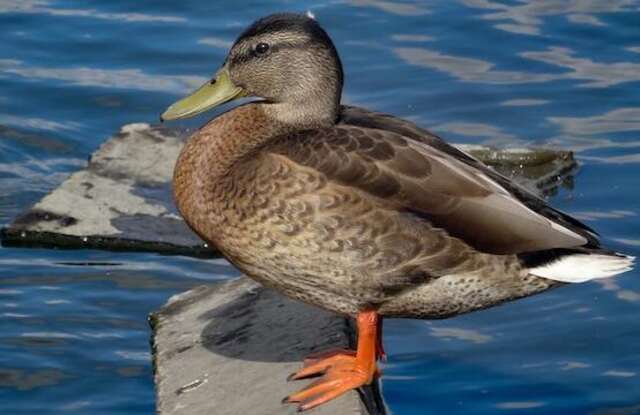
Rarely Known Small Details
What Ducks Eat That You Wouldn’t Expect
While it’s common knowledge that ducks eat plants and small animals, what many people don’t know is that some species of ducks have been known to consume small amphibians like frogs or tadpoles.
While this may come as a surprise to some, it’s important to note that not all species of duck eat the same thing.
For example, the American Wigeon is known to feed on eelgrass and other aquatic vegetation but has also been observed preying on insects, crustaceans, and even small fish.
The Lesser Scaup primarily feeds on mollusks such as clams and snails, but will also consume insects and crustaceans.
The Importance of Duck Diets in Ecosystems
In addition to the variety of foods’ ducks consume, their diet plays an important role in maintaining healthy ecosystems.
As mentioned earlier, they help control populations of aquatic plants and animals through their feeding habits. However, their diet can also have indirect effects on other organisms in the ecosystem.
For example, some ducks preferentially feed on certain types of snails, which can result in fewer snails available for other predators further up the food chain.
This can have cascading effects on populations of other organisms such as fish or birds that rely on these snails for food.
Why Understanding Rarely Known Details About Duck Diets is Important
Understanding what ducks eat may seem trivial at first glance but it’s actually crucial for conservation efforts. By understanding their feeding habits, researchers can better understand how changes in habitat or food availability affect duck populations.
Additionally, knowing what types of prey ducks consume can also help identify potential sources of contamination or pollution within the ecosystem.
For example, if a duck population suddenly starts consuming fewer mollusks than normal, it could be an indication that there is something wrong with the water quality.
The Bottom Line
While it may seem like a small detail, understanding what ducks eat in a pond can have far-reaching consequences for the health of ecosystems.
With their varied diets and unique feeding behaviors, ducks are an important part of many aquatic food webs.
By continuing to study their feeding habits, we can better protect these valuable species and the ecosystems they call home.
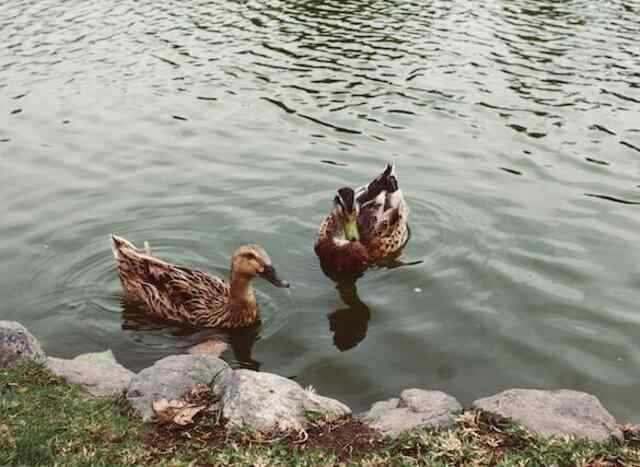
Conclusion
Throughout this article, we have discussed what ducks eat in a pond. We have learned that ducks consume both plant and animal matter, with their diet varying depending on the species and location.
Ducks commonly consume algae, grasses, aquatic plants, insects, mollusks, and small fish. However, some species of duck have been known to consume small amphibians like frogs or tadpoles.
Understanding what ducks eat is crucial for maintaining healthy ecosystems. Ducks play an important role in controlling the populations of organisms they feed on.
Overconsumption of certain prey can lead to imbalances in the ecosystem. For example, if ducks consume too many small fish in a pond, it could lead to an overpopulation of insects.
By understanding the types of food that ducks need to maintain a healthy diet and strong population numbers, conservation efforts can be focused on preserving habitats where these foods are plentiful.
Protecting habitats where aquatic plants grow abundantly or where small fish populations thrive can help ensure that ducks have access to the resources they need.
Additionally, knowing what ducks eat in a pond can help us identify areas where pollution or human activity may be negatively affecting their food sources.
By addressing these issues promptly and appropriately through conservation efforts or pollution control measures, we can help preserve healthy ecosystems for these birds.
Studying what ducks eat is essential to maintaining healthy ecosystems and ensuring that these beautiful birds continue to thrive in nature’s complex web of life.
So let us all join hands in preserving nature’s beauty by safeguarding our wetlands!
FAQs: What Do Ducks Eat In A Pond?
What do ducks eat in a pond?
Ducks typically eat a variety of things in a pond, including aquatic plants, insects, small fish, and crustaceans.
Can you feed ducks bread in a pond?
While bread is a popular food to feed ducks, it is not the best option for their health as it lacks essential nutrients and can cause digestive issues. It’s better to feed them fruits, vegetables, or duck feed instead.
What is the best food to feed ducks in a pond?
The best food to feed ducks in a pond are items that are similar to their natural diet, such as cracked corn, birdseed, oats, rice, or chopped fruits and vegetables.
Is it illegal to feed ducks in a pond?
Feeding ducks in a pond is generally not illegal, but it is important to follow any local regulations or guidelines that may exist to protect the health of the ducks and the pond.
How often should you feed ducks in a pond?
It is recommended to feed ducks in a pond only once or twice a day, with enough food for them to eat in about 5-10 minutes. Overconsumption of food can result in excessive weight gain and various health complications.
How much food should you give ducks in a pond?
A general rule of thumb is to give ducks in a pond about 1/4 to 1/2 cup of food per duck per day. It is crucial to avoid overfeeding ducks as it can cause issues for both the ducks and the pond.
What should you not feed ducks in a pond?
Avoid feeding ducks in a pond any foods that are not healthy for them, such as bread, chips, or processed foods. Also, make sure not to give them anything that is moldy or spoiled.
Can ducks survive on pond food alone?
Ducks can survive on pond food alone if the pond has enough natural food sources, such as plants and insects. However, they may benefit from supplemental feeding with items like birdseed or cracked corn.
Why is it important not to overfeed ducks in a pond?
Overfeeding ducks in a pond can lead to health problems, such as obesity and malnutrition. It can also cause the water to become polluted and potentially harm other animals that live in the pond.
Can ducks eat fish in a pond?
Ducks in a pond may eat small fish, but they typically prefer other foods like insects and plants. It’s important not to introduce non-native fish species to a pond, as they can upset the balance of the ecosystem.

